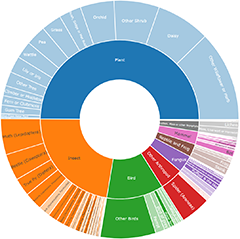Rodents
PHOTOGRAPHY OF SMALL MAMMALS FOR IDENTIFICATION
Most photos of small terrestrial mammals submitted to Canberra Nature Map for identification that were photographed in the Canberra suburban area are of a Black Rat (Rattus rattus). The next most likely species is the House Mouse (Mus musculus). Outside the city, at present, photos of Black Rats outnumber all other small mammal photos combined. However you may have found something different. Here are some tips for what to include in your photos to increase the potential for correct identification:
- An image that is sharp, not blurry;
- A scale;
- A view of the whole animal (preferably stretched out if it is a carcass);
- Views of every surface - (not always possible but ideally this includes a profile of the head, good views of the ears, the belly, the pads on the hind feet, and a good view of the fur and skin on the tail from below and above);
- Views of the teeth; and
- a count of the number of teats
Anti-coagulant poisoning is seen frequently.
Most rats seen about in daytime in southern areas of Australia are moribund due to baiting with anti-coagulant toxins such as Brodifacoum. As such they are attractive to birds such as owls and raptors, which are very sensitive to 2nd generation anti-coagulants such as Brodifacoum. 1st generation products such as Warfarin are less dangerous because they are metabolised more quickly by the victim. Moribund rats should be picked up under a towel, then humanely killed. All carcasses should be disposed of where animals cannot get them. A better approach is to rodent-proof food sources such as chook feeders, hen houses, and compost containers; and to use traps rather than baits. New age 'deterrents' such as Ultra-sonic devices do not work.
Announcements
There are currently no announcements.
Discussion
Rattus rattus
Hydromys chrysogaster
Hydromys chrysogaster
Hydromys chrysogaster
Hydromys chrysogaster
Top contributors
- AustralianPlatypusConservancy 204
- Waterwatch 131
- Gaia 68
- RodDeb 32
- AlisonMilton 26
- PEdwards 22
- davidcunninghamwildlife 22
- MichaelBedingfield 21
- rawshorty 21
- MartinPredavec 20
Top moderators
- DonFletcher 177
- MartinPredavec 147
- Waterwatch 139
- MichaelBedingfield 92
- MichaelMulvaney 81
- JoelStibbardBCT 81
- Gaia 70
- Liam.m 40
- davidcunninghamwildlife 32
- BelindaWilson 10











